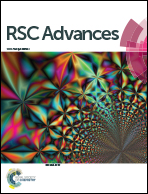Blocking the back reaction in quantum dot sensitized solar cells via surface modification with organic molecules
Abstract
Back reactions were suppressed effectively by double blocking barrier, organic molecules and ZnS on the photoanode of quantum dot (QDs) sensitized solar cells (QDSSCs), thereby achieving higher conversion efficiency. In this work, four different organic molecules were applied in QDSSCs, the efficiency increased two-fold from 2.21% to 4.25% when co-modifications with 4-tert-butyl pyridine (TBP) and ZnS were sequentially applied. The incident photon-to-current efficiency (IPCE) and parameters obtained from impedance spectroscopy (IS) such as recombination resistance (Rrec), chemical capacitance (Cμ), and electron lifetimes were consistent with the measured photovoltaic performance. We speculated that organic molecules mainly inhibit the charge recombination of the injected electrons in TiO2 with electrolyte, because of its steric factor and the electron-donating property of the tert-butyl group. The selective site of modification has been tested for assessing the dominant mechanism underlying the improvement of solar cell characteristics.


 Please wait while we load your content...
Please wait while we load your content...